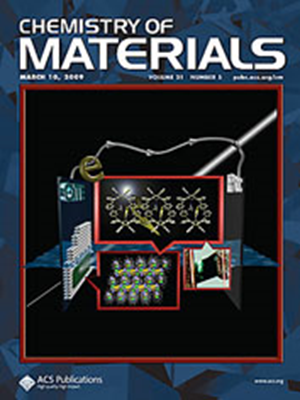Deposition and Degradation Mechanism of Zinc Thiolate Thin Films via Hybrid Molecular Layer Deposition
IF 7.2
2区 材料科学
Q2 CHEMISTRY, PHYSICAL
引用次数: 0
Abstract
Many applications, such as those in energy, digital, and medical technologies, are driving the development of new materials. Recently studied materials such as hybrid metal organic thin films are of special interest because they provide the tunability of organic components while maintaining the functionality of the metal oxide or metal sulfide constituents. In this work, we developed a process for producing zinc thiolate thin films, which contain Zn–S–C bonds, via hybrid molecular layer deposition. Using two different organic linkers, we studied the effects of chain length on the final film structure and stability. The chemical composition of the as-deposited zinc thiolate film with a butyl chain was Zn:S1.2±0.2:C3.1±0.9:O0.6±0.5 for a deposition temperature of 120 °C and Zn:S1.5±0.2:C4.1±1.1:O0.4±0.3 for a deposition temperature of 100 °C, while the composition with an ethyl chain was Zn:S0.9±0.2:C2.3±0.6:O1.2±0.7, determined via ex situ XPS analysis. We studied the degradation mechanism of these hybrid thiolate films and found them to degrade on a time scale of weeks, a much slower rate than that of previously reported analogous, alcohol-functionalized hybrid films, and to predominantly form ZnO and oxidized sulfur species in the film while releasing volatile species.

求助全文
约1分钟内获得全文
求助全文
来源期刊

Chemistry of Materials
工程技术-材料科学:综合
CiteScore
14.10
自引率
5.80%
发文量
929
审稿时长
1.5 months
期刊介绍:
The journal Chemistry of Materials focuses on publishing original research at the intersection of materials science and chemistry. The studies published in the journal involve chemistry as a prominent component and explore topics such as the design, synthesis, characterization, processing, understanding, and application of functional or potentially functional materials. The journal covers various areas of interest, including inorganic and organic solid-state chemistry, nanomaterials, biomaterials, thin films and polymers, and composite/hybrid materials. The journal particularly seeks papers that highlight the creation or development of innovative materials with novel optical, electrical, magnetic, catalytic, or mechanical properties. It is essential that manuscripts on these topics have a primary focus on the chemistry of materials and represent a significant advancement compared to prior research. Before external reviews are sought, submitted manuscripts undergo a review process by a minimum of two editors to ensure their appropriateness for the journal and the presence of sufficient evidence of a significant advance that will be of broad interest to the materials chemistry community.
 求助内容:
求助内容: 应助结果提醒方式:
应助结果提醒方式:


